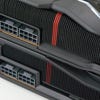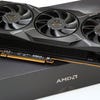AMD Radeon RX 7900 XT and 7900 XTX review: can RDNA 3 bring the value?
The XTX is worthy of consideration, but the XT is simply too expensive.
The story so far with the next generation of PC graphics cards is fairly straightforward: it kicked off with the launch of the RTX 4090, which delivered flagship performance across the board, backed by a vision from Nvidia of a whole new era for PC gaming with ray tracing at the forefront. The story turned sour with RTX 4080 - a fine GPU with an excessively poor price-point. AMD is striking back right now with its RDNA 3-powered RX 7900 XTX and 7900 XT at a point where Nvidia's 4080 misstep offers the Radeon team the biggest opportunity in years to strike back. The excitement is palpable, the prospect of competition against a dominant market leader is mouthwatering - but while the RX 7900 XTX in particular can impress, there isn't quite the killer blow here many would have hoped for - and there's palpable disappointment with RX 7900 XT.
Going into this generation, AMD offered up performance figures suggesting a 1.5x to 1.7x performance multiplier for the RX 7900 XTX when compared against the outgoing RX 6950 XT, its current flagship. Those performance increases can be achieved, but the boost to frame-rates is not uniform across the board - going into this review period, the hype suggested that the XTX should be knocking on the door of RTX 4090 performance in rasterisation, while soundly thrashing the RTX 4080. This does happen, but not with the kind of frequency that establishes this as the norm. Meanwhile, the RX 7900 XT is simply too cut back compared to its flagship counterpart to justify its price - it's a major misstep from AMD.
Of course, that's looking at the new RDNA 3 cards simply in terms of their performance. At the engineering level - and from a strategic perspective - the new offerings, based on the Navi 31 processor, are innovative and impressive. Moving on from the concept of a monolithic processor surrounded by memory modules, AMD has taken the chiplet approach that worked so well with Ryzen and adapted it for graphics. The GCD is a 5nm TSMC-produced chiplet that sits at the heart of the new cards providing the raw graphics power, surrounded by MCDs on the cheaper 6nm node which house the Infinity Cache - 80MB on the RX 7900 XT, 96MB on the 7900 XTX. Smaller chips are more cost-efficient and potentially more scalable. While there's only one GCD with Navi 31, the endgame is obvious: scale up performance by interfacing more GCDs together in the same way that AMD scales up CPU performance in Ryzen.
Beyond that, the RDNA 3 cards offer up a few more advantages: the Radiance Display engine is state-of-the-art, with DisplayPort 2.1 connections opening the door to support for next-gen displays running at a maximum 1440p at 900Hz (!), 4K at 480Hz and 8K at 165Hz. This presents a nice advantage over Nvidia's latest, still running with DisplayPort 1.4, limited to 8K at 60Hz and 4K at 240Hz. With that said, I think the results we'll see suggest that the applications of those ultra-high refresh rates are limited compared to the power of the cards (and indeed the limits of current CPUs). That said, esports favourites should fare well.
| Model | CUs | Game clock | VRAM | Mem. bus | Board power | Launch MSRP |
|---|---|---|---|---|---|---|
| RX 7900 XTX | 96 | 2.3GHz | 24GB | 384-bit | 355W | $999 |
| RX 7900 XT | 84 | 2.0GHz | 20GB | 320-bit | 315W | $899 |
| RX 6950 XT | 80 | 2.1GHz | 16GB | 256-bit | 335W | $1299 |
| RX 6900 XT | 80 | 2.0GHz | 16GB | 256-bit | 300W | $999 |
| RX 6800 XT | 72 | 2.0GHz | 16GB | 256-bit | 300W | $649 |
One thing I'd like to point out before we continue is that the stated 'game clocks' in AMD's official specifications - as seen above - are very, very understated compared to actual performance, which is highly dynamic. Riva Tuner Statistics Server reported frequencies more in the 2.6GHz to 2.8GHz range in my tests, and at 1080p I even saw the 7900 XTX flirt with 2.9GHz. In terms of the frequency war against Nvidia, RDNA 3 seems to be broadly comparable with the Ada Lovelace cards. I mention this as sub-par clocks were one of the primary surprises/disappointments from the RDNA 3 reveal - the reality is just fine.
Moving onto the physical form factor of the new RX GPUs, the cards we have for review today came directly from AMD and are the reference editions - and the sanest designs we've seen. Similar to what's happening with Nvidia's new top-end offerings, third-party cards seem to be excessively large. The reference designs look like standard, reasonably-sized, well-designed, solidly constructed GPUs, both of which require two standard eight-pin PCI Express power inputs. We're seeing an evolution of the design language seen with the RDNA 2 cards and I'd consider these to be attractive, understated designs.
Video outputs are absolutely fine too: we're looking at two of those desirable DisplayPort 2.1 sockets, paired with a single HDMI 2.1 port and a USB-C output. The latter option there also supports full DisplayPort 2.1 bandwidth, by the way. This is a decent collection of options here, but I do wish that the small USB-C port was provided in addition to a third DisplayPort, as we saw on Nvidia's reference RTX 2000 cards (unfortunately, GeForce cards cut USB-C in the last generation).
With each new generation we hope to see an increase in performance, but we also want to see power draw remain much the same or indeed decrease - which is pretty much exactly what we saw with RTX 4080. For judging RDNA 3's power consumption, I chose four titles - two with ray tracing fully enabled at 4K, two without.
For the non-RT titles, I chose a game where performance seemed under par on RDNA 3 in the form of Forza Horizon 5, along with another title where the new architecture performs well, Hitman 3. These benchmarks were taken separately to the performance numbers elsewhere and in the case of Dying Light 2, from different content (I used the actual in-game benchmark for this, not the intro).
By measuring average power consumption across the bench in watts, then dividing by the frame-rate, we're left with the measurement we're looking for: joules per frame, the lower the better. These tests were all fresh for this review, using Nvidia's PCAT interposer, which sits between power inputs and GPU, while also measuring power taken from the motherboard's PCIe slot.
| Radeon RX 6900 XT | Radeon RX 7900 XT | Radeon RX 7900 XTX | GeForce RTX 4080 | |
|---|---|---|---|---|
| Control, 4K, High RT | 300W/22fps - 13.36 Joules Per Frame | 305W/30fps - 10.2 Joules Per Frame | 349W/36fps - 9.7 Joules Per Frame | 302W/44fps - 6.86 Joules Per Frame |
| Dying Light 2, 4K, Ultra RT | 299W/24fps - 12.46 Joules Per Frame | 306W/30fps - 9.0 Joules Per Frame | 351W/38fps - 9.23 Joules Per Frame | 301W/50fps - 6.02 Joules Per Frame |
| Forza Horizon 5, 4K, Extreme, RT Off | 287W/89fps - 3.22 Joules Per Frame | 302W/100fps - 3.02 Joules Per Frame | 344W/113fps - 3.04 Joules Per Frame | 224W/121fps - 1.85 Joules Per Frame |
| Hitman 3, 4K, Max, RT Off | 309W/130fps - 2.38 Joules Per Frame | 309W/175fps - 1.77 Joules Per Frame | 355W/196fps - 1.81 Joules Per Frame | 301W/181fps - 1.66 Joules Per Frame |
In the RTX 4080 review, we saw some impressive efficiency from Nvidia - a drop of 30-50 percent in power consumption per frame compared to RTX 2080 and 3080. However, AMD doesn't perform as well with RDNA 3. The RTX 4080 delivered a 51 percent power reduction over RTX 3080 in Forza Horizon 5, but here both RX 7900 XT and 7900 XTX show only a five to six percent reduction in power.
On the flipside, Hitman 3 with RT disabled is much closer to Nvidia in terms of efficiency - and is more impressive up against RDNA 2's RX 6900 XT. There's 24 per cent power reduction for the RX 7900 XTX against its preceding flagship, rising to 26 per cent with the slightly-more-efficient RX 7900 XT.
Moving onto RT titles, we should expect Nvidia to be far more efficient owing to its dedicated RT hardware and higher performance - and it clearly is. Up against the RX 6900 XT though with Control, there's a 27 percent reduction in power for the 7900 XTX, dropping to 24 percent with the 7900 XT. Moving onto Dying Light 2's new benchmark, the RX 7900 XTX sees a 27 percent reduction in power consumption, while the XT model sees that increase a touch to 28 percent.
The overall takeaway is that the RDNA 3 cards consume more power than the RX 6900 XT, and while the frame-rate increase is proportionately higher than the increase in power draw in three of the four tests, I would have hoped to have seen better results overall. Meanwhile, the Forza Horizon 5 result is baffling, showing very little improvement from a revised architecture and a superior process node.
Now let's move onto the benchmarks, but before we kick off, here's a quick outline of the new PC we've built to help test this new generation of GPUs. Sitting at the heart of our system is an Intel Core i9 12900K, running with P-cores at 5.2GHz and E-cores at 3.9GHz. The CPU is augmented with 6000MT/s Trident Z5 RGB DDR5 memory from G-Skill. The Noctua NH-D15 is our cooler of choice for handling the powerful processor, while all titles are run from PCIe Gen 3 NVMe SSDs. All components are mounted in an Asus ROG Maximus Hero Z690 motherboard, while power is supplied by a Corsair RM1000i power supply.
AMD Radeon RX 7900 XT and 7900 XTX analysis
- Introduction, hardware and power analysis [This Page]
- RT benchmarks: Dying Light 2, Cyberpunk 2077, Control, F1 22
- RT benchmarks: Hitman 3, Metro Exodus Enhanced Edition, Marvel's Spider-Man Remastered
- RT/DLSS vs FSR2 benchmarks: Cyberpunk 2077, Dying Light 2, Marvel's Spider-Man Remastered
- Game benchmarks: Control, Cyberpunk 2077, Doom Eternal
- Game benchmarks: F1 22, Gears 5, Hitman 3
- Game benchmarks: Forza Horizon, Red Dead Redemption 2, Shadow of the Tomb Raider
- AMD Radeon RX 7900 XT and 7900 XTX: the Digital Foundry verdict








